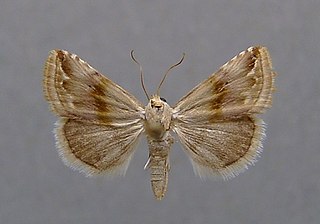Related Research Articles

Curetis thetis, the Indian sunbeam, is a species of lycaenid or blue butterfly found in Indomalayan realm.

Meandrusa sciron, the brown gorgon, is a species of swallowtail found in parts of South Asia and Southeast Asia. It belongs to the hooked swallowtails genus, Meandrusa, of the family Papilionidae. The butterfly is found in India from Sikkim to Assam and north Burma and is not considered to be threatened. Though not uncommon, it is protected under Indian law under the name gyas.
Copticostola is a genus of moths in the family Gelechiidae. It contains the species Copticostola acuminata, which is found in Tabasco, Mexico.

Apamea scolopacina, the slender brindle, is a moth of the family Noctuidae. The species was first described by Eugenius Johann Christoph Esper in 1788. It is found across the Palearctic realm from central Europe to the Kuril Islands northeast of Japan.

Eublemma ostrina, the purple marbled, is a moth of the family Erebidae. The species was first described by Jacob Hübner in 1808. It is mainly found in central and southern Europe, and further east, but is also a scarce migrant in the United Kingdom, where it is mainly found along the south coast.
Brenthia pleiadopa is a species of moth of the family Choreutidae first described by Edward Meyrick in 1921. It is found in Magude, Mozambique.
Rhynchoferella syncentra is a moth of the Copromorphidae family. It is found in Madagascar and South Africa, where it is known from Kwazulu-Natal, Mpumalanga and Gauteng.
Polygrammodes supremalis is a moth in the family Crambidae. It was described by William Schaus in 1920. It is found in Paraná, Brazil.
Praeacrospila patricialis is a moth in the family Crambidae. It was described by William Schaus in 1912. It is found in Costa Rica.
Pycnarmon peruvialis is a moth in the family Crambidae. It was described by George Hampson in 1917 and it is found in Peru.
Ectaga lictor is a moth in the family Depressariidae. It was described by Walsingham in 1912. It is found in Guatemala.
Compsoctena media is a moth in the Eriocottidae family. It was described by Walsingham in 1897. It is found in the Central African Republic.
Dichomeris xuthostola is a moth in the family Gelechiidae. It was described by Walsingham in 1911. It is found in Mexico (Tabasco).
Dichomeris zonaea is a moth in the family Gelechiidae. It was described by Edward Meyrick in 1921. It is found in Zimbabwe.
Chionodes concinna is a moth in the family Gelechiidae. It is found in Mexico (Guerrero).
Gelechia cuneifera is a moth of the family Gelechiidae. It is found in Mexico (Guerrero).
Compsolechia metadupa is a moth of the family Gelechiidae. It was described by Walsingham in 1910. It is found in Mexico (Tabasco).
Compsolechia succincta is a moth of the family Gelechiidae. It was described by Walsingham in 1910. It is found in Mexico (Tabasco) and Jamaica.
Aristotelia chalybeiochroa is a moth of the family Gelechiidae. It was described by Walsingham in 1897. It is found in West Indies, where it has been recorded from St. Thomas.
Gonioterma chromolitha is a moth of the family Depressariidae. It is found in Bolivia.
References
- ↑ Beccaloni, G.; Scoble, M.; Kitching, I.; Simonsen, T.; Robinson, G.; Pitkin, B.; Hine, A.; Lyal, C., eds. (2003). "Ectaga canescens". The Global Lepidoptera Names Index . Natural History Museum . Retrieved May 22, 2018.
- ↑ Ectaga at funet
- ↑ Biol. centr.-amer. Lep. Heterocera 4 : 141
| This article on a moth of the subfamily Depressariinae is a stub. You can help Wikipedia by expanding it. |